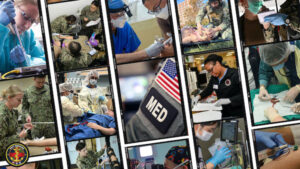
Story by Bobbie Camp
U.S. Navy Bureau of Medicine and Surgery
Since the dawn of our nation, U.S. Navy Bureau of Medicine and Surgery (BUMED) has been responsible for the care and operational readiness of our warfighters. This has been the focal point that’s guided us for more than 249 years. As the Navy Medicine Enterprise (NME) continues to navigate toward its 2027 North Star to modernize its culture, organization and platforms, October marks several significant anniversaries of historic shifts in its operational mission.
To prioritize Navy Medicine’s focus on readiness and support changes in our organizational construct, two medical type commands (TYCOMs) were realigned as Naval Medical Forces Atlantic (NMFL) and Naval Medical Forces Pacific (NMFP), and healthcare education and training command, Naval Medical Forces Development Command (NMFDC) – formally known as Naval Medical Forces Support Command (NMFDC) – on Oct. 1, 2019. In parallel, most of the Navy Medicine Readiness and Training Commands (NMRTCs)/Units (NMRTUs) were officially stood up.
“Navy Medicine continues to align its medical warfighters and platforms to enhance warfighting performance contributing to the Department of the Navy’s ability to leverage integrated deterrence against our adversaries and to provide ready and relevant health services capabilities across the maritime domain,” stated Rear Adm. Darin Via, Navy Surgeon General and chief, BUMED.
The Military Health System (MHS) went through a significant congressionally directed reform in the 2017 National Defense Authorization Act to reshape military medicine to better support warfighters. DHA assumed administration and management of all military treatment facilities (MTF) on Oct. 1, 2019. Naval Hospital Jacksonville was the first Navy hospital to transition to DHA and NMRTC Jacksonville was established on Oct. 1, 2018.
“Navy Medicine’s organizational structure will be organized to facilitate all phases of force development, force generation and force preservation and full restoration of the warfighter,” said Rear Adm. Rick Freedman, deputy Surgeon General.
Within the context of supporting fleet concepts, Navy Medicine provides several EXMED capabilities and augments fleet capabilities that are designed to integrate and maneuver with the maritime force, operating in the littorals and from the sea. EXMED capabilities to include en-route care systems, expeditionary resuscitative surgical systems, expeditionary medical units, forward deployable preventive medicine units, expeditionary medical facilities, and personnel augments to hospital ships, and casualty receiving and treatment ships.
“This shift has allowed the Navy to retain command of our uniformed medical forces in support of operational missions,” concluded Via. “While we are supporting MHS stabilization at the MTFs, this naval command structure provides a single point of command for the fleet commanders and lifelines for our Sailors and their families.”
There are currently more than 19,000 personnel assigned to 29 NMRTCs and 35 NMRTUs who are co-located at MTFs throughout the globe to provide combat-ready providers to the fleet. NMRTCs/NMRTUs preserve the U.S. Navy’s critical equities while providing a structure that allows our highly skilled personnel to maintain proficiencies through valuable training in an MTF. NMRTCs report to NMFL and NMFP, which in turn are accountable to BUMED.
The Navy Medicine Enterprise – represented by more than 44,000 highly-trained military and civilian health care professionals – provides enduring expeditionary medical support to the warfighter on, below, and above the sea, and ashore.